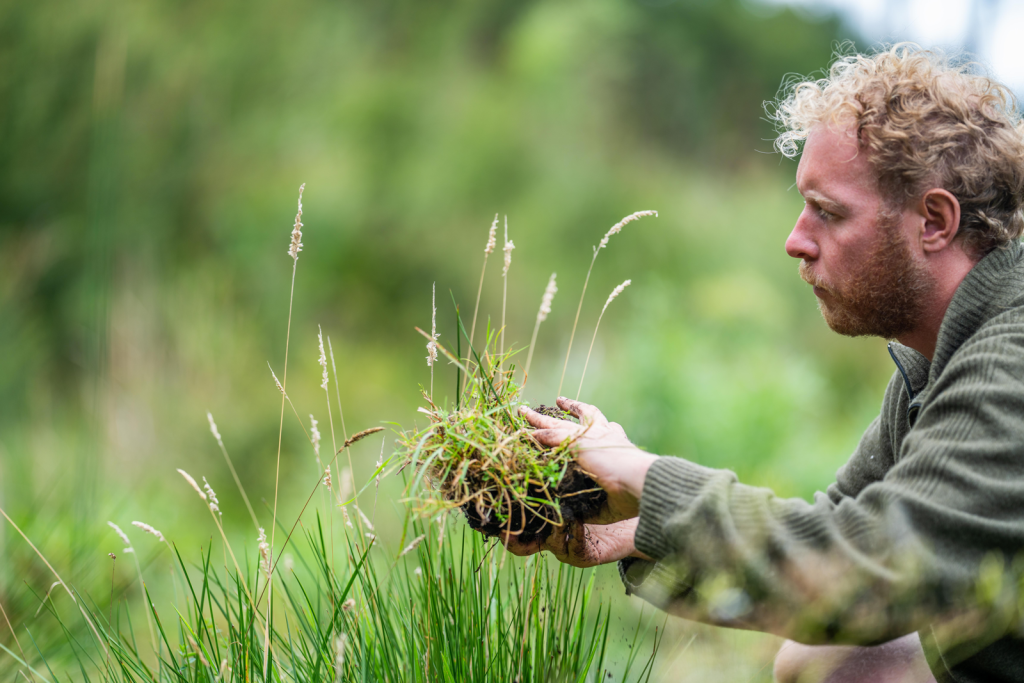How Beneficial Soil Microbes Support Native Grass Establishment and Long-Term Success
When most people think of a successful Conservation Reserve Program (CRP) planting, they imagine healthy stands of native grasses and vibrant wildflowers waving in the wind. But what’s happening beneath the surface is just as important, and often overlooked. One of the most critical, yet invisible, contributors to CRP success is mycorrhizal fungi.
These beneficial soil microbes form symbiotic relationships with native plants, especially grasses and forbs, enhancing root health, improving nutrient uptake, and increasing resilience in challenging environments. At FDCE, we recognize the vital role these fungi play and incorporate strategies to support healthy soil microbial communities in every CRP project we establish.
What Are Mycorrhizal Fungi?
Mycorrhizal fungi are microscopic soil organisms that colonize plant roots and extend far into the soil with thread-like filaments known as hyphae. This vast underground network:
- Expands a plant’s root surface area
- Helps access water and nutrients, especially phosphorus
- Creates soil aggregates for improved structure and erosion resistance
In exchange, the plant provides the fungi with sugars produced through photosynthesis. This symbiotic relationship is one of nature’s most effective partnerships.
Why Mycorrhizal Fungi Matter in CRP Establishment
Enhance Root Development and Plant Establishment
During the early stages of a CRP planting, native grasses and forbs often struggle in poor or degraded soils. Mycorrhizal fungi:
- Increase root growth and vigor
- Help young seedlings access water during dry periods
- Enable faster and more even establishment across the site
This results in better stand density and a stronger start, especially in low-fertility or eroded areas.
Improve Nutrient Uptake
Many native plants are adapted to nutrient-poor soils, but even they can benefit from extra help. Mycorrhizal fungi improve absorption of hard-to-reach nutrients, including:
- Phosphorus
- Nitrogen
- Micronutrients like zinc and copper
This is particularly useful on CRP fields where fertilizers are not applied or are limited by program requirements.
Increase Drought and Stress Tolerance
The extensive fungal networks act like an underground irrigation system, helping plants survive in dry conditions. This is crucial in areas prone to seasonal droughts or during the vulnerable first year of CRP establishment.
Promote Soil Structure and Erosion Control
Mycorrhizal fungi contribute to soil aggregation by binding soil particles together with their hyphae, and by producing a sticky compound called glomalin that:
- Improves water infiltration and retention
- Reduces runoff and erosion
- Enhances long-term soil health
How FDCE Supports Soil Microbial Health in CRP Projects
At FDCE, we incorporate soil biology into every stage of CRP establishment by:
Avoiding excessive tillage:
Minimizing soil disturbance preserves fungal networks already present in the soil.
Using high-quality native seed:
Our seed mixes are selected to be compatible with and supportive of mycorrhizal colonization.
Supporting early root development:
We use FDCE’s proprietary BOOST micronutrient enhancement blend to increase seedling vigor, giving plants the best start for forming beneficial symbioses.
Tailoring herbicide applications:
Our site-specific herbicide programs control weeds without harming underlying soil biology, preserving microbial integrity.
Looking Below the Surface for Long-Term Success
Mycorrhizal fungi may be invisible to the naked eye, but their impact on CRP success is significant and long-lasting. By fostering healthy microbial communities, we ensure that native vegetation not only takes root, but thrives.
CRP projects that prioritize soil health are more resilient, more diverse, and more beneficial to the surrounding ecosystem. That’s why FDCE integrates biological insights into every part of our turnkey establishment process.
Partner with FDCE for Soil-Smart Conservation
If you’re looking to improve the health and success of your CRP land, it’s time to think beyond the seed. FDCE’s deep understanding of soil ecology, native vegetation, and USDA compliance means your project is supported from the ground up, literally.
Contact us today to learn more about how we build strong foundations for conservation success, one root (and fungus) at a time.

